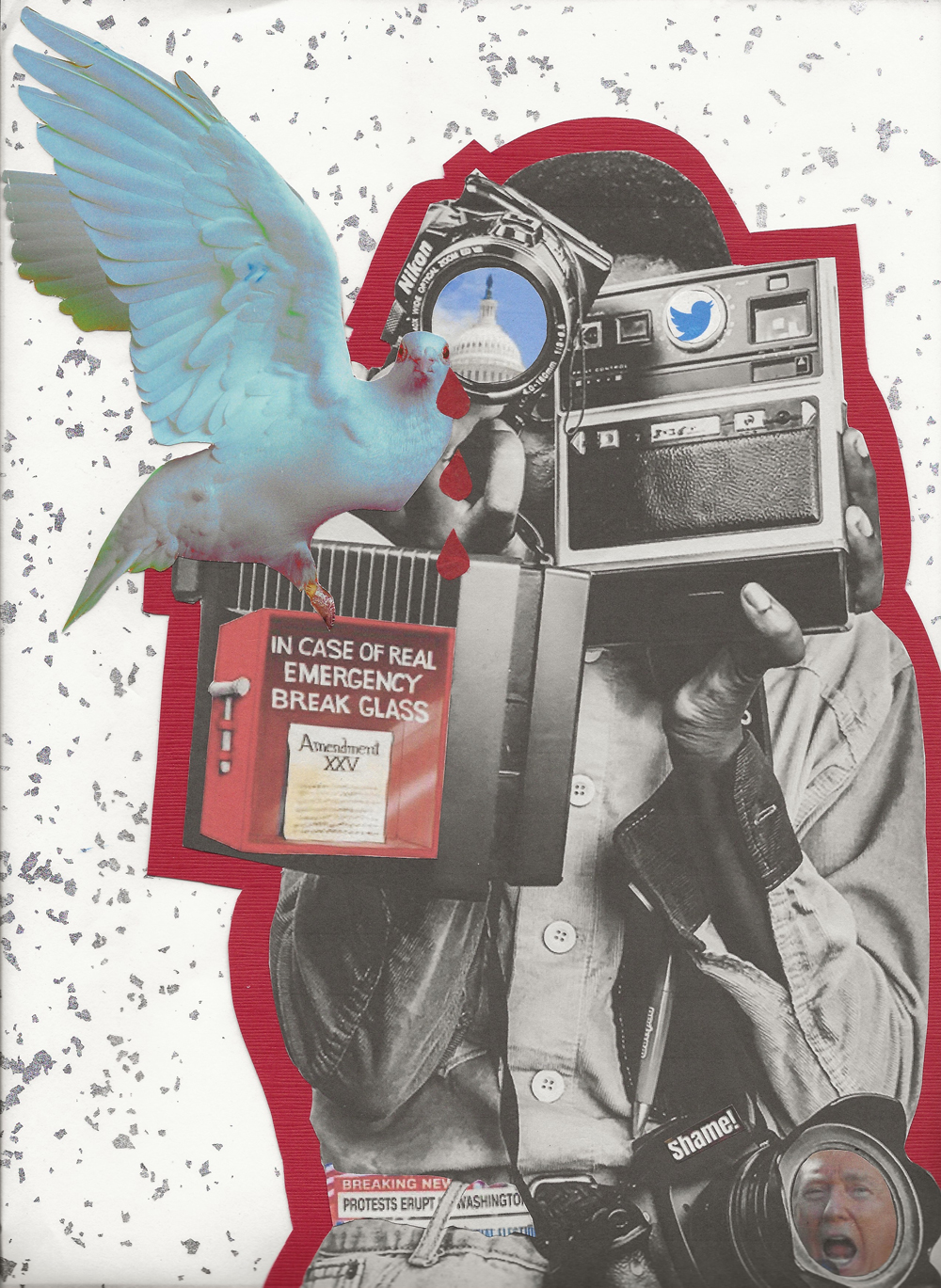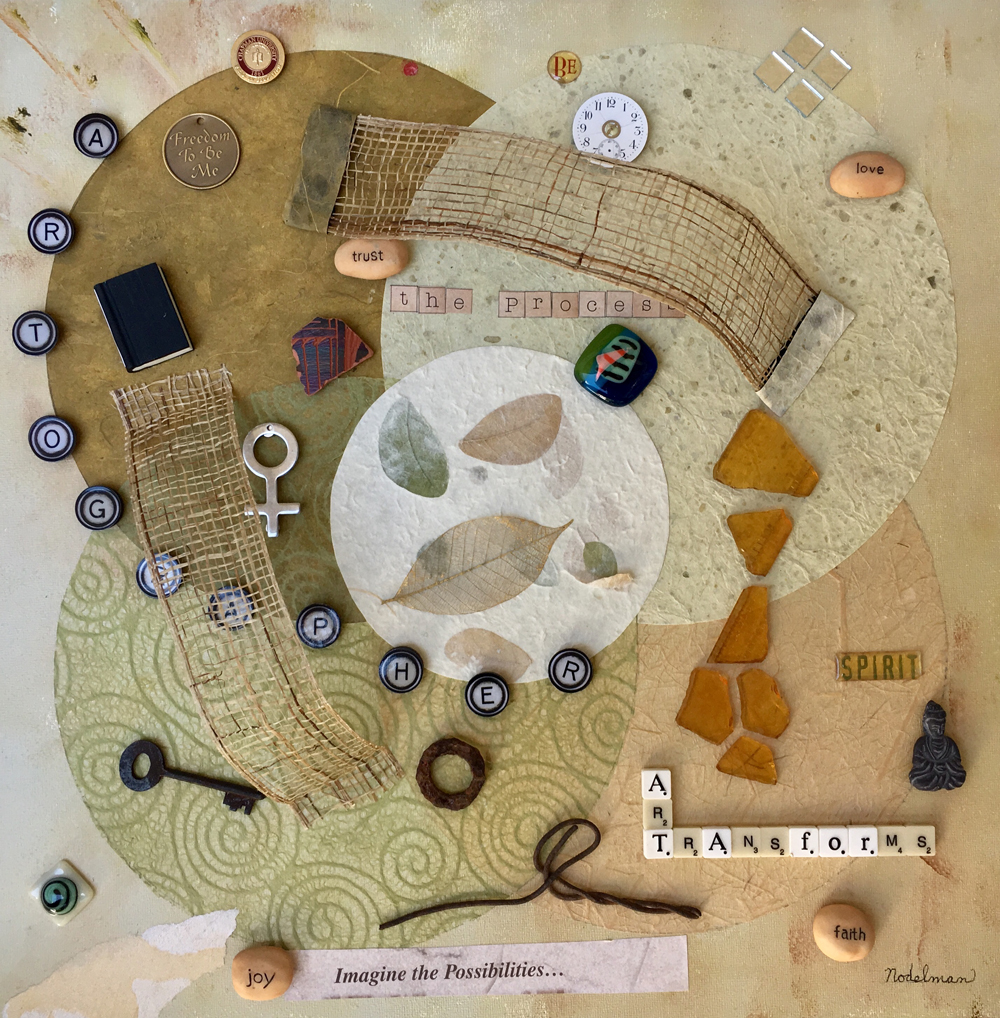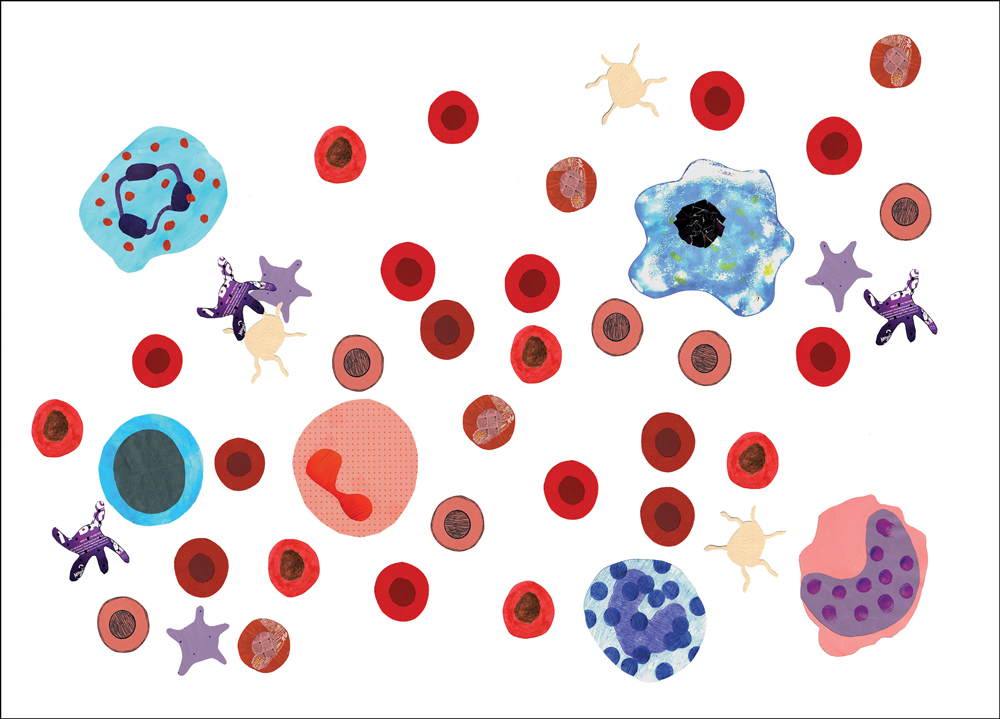
12″x9″; collage on silver leaf-flecked paper with Week 01, 2021 Collage Challenge for the Paris Collage Collective. Images sourced from Google Images, dove from cover of Vanity Fair’s Holiday issue 2020-2021, CNN “Breaking News” caption, Twitter icon, red construction paper. Photograph taken by Jakayla Toney; 2021. Courtesy of the artist.
SYMPOSIUM AT KOLAJ FEST NEW ORLEANS 2025
Artist as Scientist, Scientist as Artist: Research, Collage, & The Pursuit of Knowledge
EVENT WEBSITE | REGISTER
Kolaj Fest New Orleans is a multi-day festival and symposium about contemporary collage and its role in art, culture, and society, 25-29 June 2025. Visit the website to learn more, see an overview of the program, and register to attend.
At Kolaj Institute, we consider acts of play critical to a collage artist’s practice. Rummaging through a second hand book store, flipping through pages of old magazines, seeing what happens when a box of cut fragments is spilt on the floor and other acts of randomness in the studio can unlock new paths of creativity. We may go so far as to claim that the artist’s role in society is to play professionally. The obverse of play is research which can be thought of as a directed form of play. Seeking out specific materials, reading about how they were made, investigating their historical context, and writing about their meaning or how meaning has changed over time can be essential to building context for artwork that unlocks a deeper, more meaningful experience for the viewer. Play and research are driven by a sense of curiosity and the two activities are so fundamental to practice that artists may often be engaged in deep play or deep research without even realizing it.
By contrast, historically, academics rarely consider art a valid form of inquiry. “The idea that the arts could be at the core of research seemed more than a bit oxymoronic,” said American educator Elliot Wayne Eisner to a conference in Ireland in 2005. He spearheaded a movement to get researchers to think about art making as a valid tool for qualitative inquiry. “It was in 1993 that the first Arts-Based Research Institute was offered at Stanford University to members of the American Educational Research Association. The Institute has been offered at Stanford and at Arizona State University virtually every other year since then. My aim in initiating the institute was driven by a tension that I felt personally as a scholar trained in the social sciences but immersed in the arts. That tension engendered the idea that the arts might be used in some productive way to help us understand more imaginatively, and more emotionally, problems and practices that warrant attention in our schools.”
We often say that art is a way to make sense of our world, not simply intellectually, but emotionally. At the core of the Arts-based Research movement is an attempt to understand how that works theoretically. Eisner explained, “Seeing is necessary in order to have a content to express. Expression is necessary to make public the contents of consciousness, and so what we have here is an imaginative transformation of a perceptual event that is imbued with meaning whose features and significance the students try to transform into language capable of carrying that meaning forward.” If we can feel the idea, then we can make it visual. If we can make it visual, then we can describe what we see. Language takes shape to express the idea; new knowledge is created.
Mary Somerville, the Scottish scientist, writer, and polymath, wrote one of the most popular 19th century books on science. On the Connexion of the Physical Sciences begins, “The progress of modern science, especially within the last few years, has been remarkable for a tendency to simplify the laws of nature, and to unite detached branches by general principles…The contemplation of the works of creation elevates the mind to the admiration of whatever is great and noble.” In his 1834 review of Somerville’s book, William Whewell coined the word scientist, based on the word science which had been used since the 14th century to describe the state of knowing. Today, science is the systematic pursuit and organization of knowledge. Less systematic, art can be viewed as a different kind of knowledge pursuit. Deeply curious and often eclectic in their explorations, collage artists share a kinship with alchemists who in their laboratories–or studios–combine things they find to see what happens. These experiments make their way into the world, where people look at them and wonder what is happening. Through this, we make sense of the world. But unlike science, which is rooted in rationality, art leverages our human capacity for irrationality in pursuit of a deeper understanding. What happens when we bring art and science together? Can we “unite detached branches” of knowledge? Can we foster deeper “contemplation of the works of creation” that “elevates the mind”? Let’s find out.
During the Symposium at Kolaj Fest New Orleans, Emily Dustman and Debora Joy Nodelman will share their experiences at the intersection of art and science.

18″x18″x2″; acrylic paint, Awagami Japanese lace paper, ephemera: typewriter keys, vintage yellow wallpaper, antique metal key, Venus symbol, broken glass, pottery shard, silk leaves, iron fragments from a Colorado mine, watch face, hand blown glass beads, magazine text, stickers, stones, plastic Scrabble pieces, mirrors, magnets, thick black book eraser (represents dissertation), Chapman University 23 K gold plated lapel pin on wood; 2008-2013. Published in Nodelman, Deborah. (2013). Creating space for possibility: Transformative practice in an elementary visual arts studio [doctoral dissertation, Chapman University]. Courtesy of the artist.
Now retired after teaching forty-one years in public education, artist and researcher Debora Joy Nodelman has engaged a study of arts-based research and documented her findings in the paper, “Constructing Knowledge in Bits and Pieces: Collage Inquiry as Arts-Based Research” which she will present at Kolaj Fest New Orleans. She wrote, “I craft collages as I research scholarly texts, current events, history, social justice issues, and matters of human nature. My practice, as an intersubjective process, supports relational meaning-making. In the selection of images, ephemera, and symbols, I interpret complex ideologies through collage to represent my experience and knowledge as well as those of others.” Nodelman will present her art practice and speak about how it relates to her written academic work. “Engaging in arts-based research practice filled me with a sense of wonder at the complexity of knowledge acquisition and its representation in both written and visual form. Understanding knowledge via collage practice proved to be a holistic, creative, transformative experience.” Nodelman will also speak about how collage is uniquely suited for Arts-based Research. “Collage became a medium for bridging the gap between the subjective and objective, between theory and practice, and between my personal and academic life while writing papers, journal articles, and my dissertation. She wrote, “Making art is risky. The fear of art making often has to do with how the final product will turn out. Perhaps collage invites risk taking, or letting go of our fears, in that the final product is uncertain.”

5″x7″; collage; 2019. Courtesy of the artist.
E-Squared is “an international print publication that draws from both art and science and is the embodiment of this synergy.” With contributions from artists, scientists, engineers, and all thinkers alike, the magazine “seeks to generate questions, creative thought, experimentation, collaboration, and innovation with the hope of sparking real social and cultural change.” In her own collage practice, Emily A. Dustman reimagines how scientific concepts are communicated, making them more accessible and emotionally resonant. She employs collage as a powerful medium for co-creation, inviting diverse communities to collectively interpret and visualize complex scientific phenomena. By layering imagery, textures, and data, she transforms abstract scientific ideas into tangible, interactive experiences that invite curiosity and dialogue. E-squared magazine founder and director Dustman will share her passion for art and science, speak about the work of the magazine, and introduce a project taking place at Kolaj Fest New Orleans.
In her article, “The Tensegrity of Art and Science,” Maria-Elizabeth Baeva noted, “Both art and science require thoughtful observation and analysis of the world around us. They build knowledge, push boundaries and empower our society.” In its systematic study of the natural world, science needs art to communicate its ideas which are often complex and novel. The work of artists is to inspire new ways of thinking and foster deeper understanding about the world. At a time when science and art are under attack, what does it look like if we bring them together?
ABOUT THE PRESENTERS
Debora Joy Nodelman is an a/r/tographer (artist, teacher, researcher) and business owner who shares her time living between Southern Ute land in Silverton, Colorado and Gabrieleno-Tongva land in Los Angeles, California. She holds a PhD in Education from Chapman University. Now retired after teaching forty-one years in public education, she enjoys spending time with her family, reading, studying, traveling, and creating mixed-media art. In addition, she spends hours at a local equestrian barn helping to care for her family horse. Nodelman’s writing is published in The International Journal of Multicultural Education, Visual Arts Research, International Journal for Researcher Development, and in the texts “Culturally Responsive Methodologies” and “Arts-Based Research Across Textual Media in Education”. Published collage work includes The Sketchbook Project Volume 16, Visual Arts Research Vol. 38, No. 2, and multiple collages for the Paris Collage Collective’s Weekly Challenges. Learn more on Instagram @debora_joy_nodelman.
Emily Dustman is an artist, scientist, and educator who has been published in various journals for research regarding species of conservation concern. Dustman has spent the last decade teaching at various colleges fusing art and science in her own curriculum and she has served as a curriculum developer and coordinator implementing STEAM initiatives (Science, Technology, Engineering, the Arts, & Mathematics) for biology departments around the nation. Dustman completed the natural science illustration program at the Rhode Island School of Design in 2015. Shortly afterwards she was commissioned to paint the Turtles of Rhode Island for the Roger Williams Park Zoo. In 2016, she founded E-Squared Magazine, which fuses her affinity for art and science. Dustman currently works in the science education field and teaches immunology, advanced molecular & cellular biology, organismal biology, and environmental science courses. She also instructs sci-art workshops at science centers, botanical gardens, and for the National Science Foundation. The artist lives and works in Saint Louis, Missouri. Learn more at www.emilydustman.com.
Kolaj Fest New Orleans is a multi-day festival and symposium about contemporary collage and its role in art, culture, and society, 25-29 June 2025. Visit the website to learn more, see an overview of the program, and register to attend.
